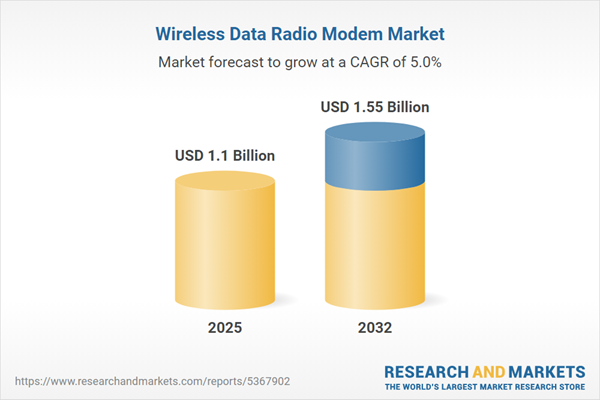Speak directly to the analyst to clarify any post sales queries you may have.
Senior leadership teams face increasing pressure to modernize enterprise connectivity strategies, with the wireless data radio modem market serving as a core enabler of secure, resilient, and scalable infrastructure that supports digital transformation and regulatory compliance objectives. Decision-makers are prioritizing reliable wireless solutions to future-proof operations in rapidly changing business environments.
Market Snapshot: Wireless Data Radio Modem Market Growth Trends
In 2024, the wireless data radio modem market is estimated at USD 1.05 billion, with projections indicating growth to USD 1.10 billion in 2025 and USD 1.55 billion by 2032. This projected CAGR of 5.03% is shaped by accelerating enterprise digitization, widespread IoT adoption, and a global need for dependable wireless communications. Strategic investments by leading organizations focus on building advanced modem networks to enhance compliance standards and operational stability, which supports secure, continuous workflows and smooth integration of connected systems at a global scale.
Scope & Segmentation: Strategic Overview for Senior Leadership
- Installation Type: Fixed wireless modems provide stable automation in static infrastructure, while mobile modems deliver essential connectivity for assets operating in the field or at remote sites.
- Component: Key hardware elements include RF transceivers and antennas that ensure swift data flow across networks. Services such as diagnostics, installation, and ongoing maintenance are critical to reducing downtime and extending product lifespan for lasting operational efficiency.
- Frequency Band: Licensed and unlicensed frequencies—including millimeter-wave, sub-1GHz, 2.4GHz, and 5GHz—allow organizations to customize wireless deployments, ensuring compliance with regional standards and performance optimization for diverse business applications.
- Network Type: A suite of connectivity technologies—4G LTE, 5G, satellite, LPWAN, and terrestrial networks—offers flexibility to meet sector-specific and geographic requirements, encouraging wider technology adoption.
- Data Rate Category: Solutions address both high-speed transfers for critical processes and standard rates for routine operations, forming the foundation for industrial automation, secure data flows, and reliable process monitoring.
- End User Segment: The market serves industries such as consumer electronics, utilities, oil and gas, government, defense, manufacturing, telecommunications, and logistics, adapting to increased demands for security, compliance, and robust network resilience.
- Regional Insights: Key regions include North and South America, EMEA, and Asia-Pacific. Adoption patterns are shaped by local standards in markets such as the United States, Brazil, Germany, UAE, South Africa, China, India, and Japan, influencing both technology requirements and deployment strategies.
- Market Leaders: Influential players include Quectel Wireless Solutions, Fibocom Wireless, Sierra Wireless, u-blox Holding, Thales, Digi International, CalAmp, Huawei Technologies, Advantech, and Multi-Tech Systems, setting benchmarks that help shape sectoral growth and direction.
Key Takeaways for Senior Decision-Makers
- Centralized management platforms and robust security frameworks are essential for improving network oversight and safeguarding enterprise assets, particularly for organizations operating across multiple or distributed locations.
- Adopting cellular and LPWAN network combinations enables organizations to achieve flexible, cost-effective connectivity, well-suited to installations in remote or challenging environments where traditional infrastructure is limited.
- Multi-channel integration, leveraging cellular, satellite, and terrestrial networks, provides organizations with the adaptability to maintain stable operations in complex or regulated regions.
- Integrating edge computing and network virtualization supports timely data analysis and proactive system monitoring, enabling operational teams to make well-informed technology and business decisions.
- Flexible wireless modem systems simplify the integration with existing legacy equipment, facilitating ongoing compliance, stronger oversight, and responsiveness to emerging standards or security concerns.
Tariff Impact on the Wireless Data Radio Modem Sector
- Tariffs on electronic components in principal markets such as the United States motivate firms to minimize risk by broadening supplier pools and strengthening supply chain processes to secure uninterrupted business continuity.
- Diversified sourcing strategies, including dual sourcing and nearshoring, reduce potential disruption and promote agile responses to shifts in international trade dynamics.
- Implementing adaptable procurement models—ranging from leasing to multi-year agreements—helps stabilize budgeting and can buffer enterprises from unexpected trade volatility, protecting essential operations.
Methodology & Data Sources
This analysis is based on interviews with senior executives, broad sector surveys, and comprehensive reviews of relevant regulatory frameworks. Scenario-driven workshops and intellectual property reviews provide additional context and depth to the findings.
Why This Report Matters: Senior Leadership Perspective
- Empowers executive teams to align wireless data radio modem investments with the latest industry standards, centering on risk management, compliance, and operational sustainability.
- Highlights essential oversight priorities such as supply chain resilience, exposure to trade fluctuations, and forward-looking infrastructure planning for sound, effective decisions.
- Provides actionable, strategic market intelligence, equipping leaders to bolster the resilience and reliability of enterprise communications systems.
Conclusion
This report enables senior decision-makers to address evolving regulatory, technological, and operational demands, fostering prudent investments and supporting sustainable growth across the wireless data radio modem landscape.
Additional Product Information:
- Purchase of this report includes 1 year online access with quarterly updates.
- This report can be updated on request. Please contact our Customer Experience team using the Ask a Question widget on our website.
Table of Contents
3. Executive Summary
4. Market Overview
7. Cumulative Impact of Artificial Intelligence 2025
Companies Mentioned
The companies profiled in this Wireless Data Radio Modem market report include:- Quectel Wireless Solutions Co., Ltd.
- Fibocom Wireless Inc.
- Sierra Wireless, Inc.
- u-blox Holding AG
- Thales S.A.
- Digi International Inc.
- CalAmp Corp.
- Huawei Technologies Co., Ltd.
- Advantech Co., Ltd.
- Multi-Tech Systems, Inc.
Table Information
| Report Attribute | Details |
|---|---|
| No. of Pages | 197 |
| Published | October 2025 |
| Forecast Period | 2025 - 2032 |
| Estimated Market Value ( USD | $ 1.1 Billion |
| Forecasted Market Value ( USD | $ 1.55 Billion |
| Compound Annual Growth Rate | 5.0% |
| Regions Covered | Global |
| No. of Companies Mentioned | 11 |









